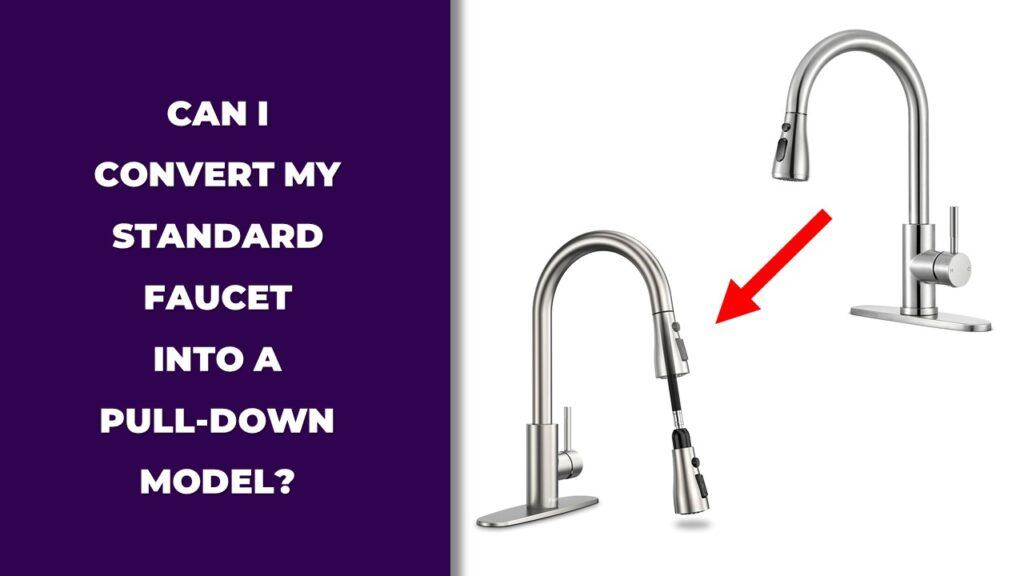
Yes, you can convert your standard faucet into a pull-down model, but here is the catch: you can only by replacing the whole thing. Pull-down faucets are taller and have a hose for more reach—great for cleaning bigger stuff in the sink. Just make sure your sink can handle it, and be ready for a bit of DIY or hire a plumber.
Let’s break down how it works, what to check before you buy, and how to install it without headaches.
What’s a Pull-Down Faucet?
A pull-down faucet is a kitchen faucet with a built-in spray head that pulls down toward the sink on a hose. It’s designed to make rinsing dishes, washing veggies, and cleaning the sink much easier than a fixed faucet. The spray head is attached to a flexible hose, which means you can aim the water exactly where you need it—no more struggling to rinse a big pot under a small spout.
These faucets are taller than regular ones and need a bit more space under the sink for the hose to retract smoothly. Most models also have different spray settings, like a steady stream for filling a pot and a spray mode for washing dishes. A pull-down faucet is a simple way to upgrade your sink’s functionality and make your daily chores a little easier.
Can You Convert an Existing Faucet Into a Pull-Down Model?
No, you can’t convert a standard faucet into a pull-down model by just adding a sprayer. A pull-down faucet is a completely different design, it comes with a built-in hose and a spray head that’s part of the faucet itself. The only way to “convert” is by replacing your old faucet entirely.
If you’re thinking about making the switch, you’ll need to check your sink first. Pull-down faucets are taller and need room for the hose to move freely. If you have limited space under your sink, like pipes, shelves, or garbage disposals in the way, you may need to make adjustments. It’s not a hard job, but it’s important to know what you’re getting into before you start.
Step-By-Step Guide: How to Replace a Standard Faucet With a Pull-Down Faucet
Here is the step-by-step guide to replace a standard faucet with a pull-down model:
- Shut off the water supply
- Remove the old faucet
- Check if your sink works with the new faucet
- Install the new pull-down faucet
- Test everything to make sure it works right
Sounds simple enough, but let’s walk through each step so you don’t miss anything important.
Tools and Materials Needed
Before you start, make sure you have everything you need. Here’s a basic list:
- Adjustable wrench
- Basin wrench (for those tight spaces)
- Plumber’s tape
- Bucket and towels
- New pull-down faucet
- Cleaning cloth and mild cleaner
- Optional: Plumber’s putty or silicone sealant (for extra leak protection)
It’s always smart to lay these tools out near your sink, so you’re not running around in the middle of the project trying to find a wrench.
Step 1: Shut Off the Water Supply
First, find the shutoff valves under your sink. They are usually small knobs near the back wall. Turn them clockwise to stop the water flow. Open the faucet to drain any leftover water and release pressure. Keep a towel or bucket handy in case water spills out.
If your sink doesn’t have shutoff valves, you’ll need to turn off the water supply for your whole house.
Step 2: Remove the Old Faucet
With the water off, grab your basin wrench or adjustable wrench and loosen the nuts that hold the faucet in place underneath the sink. Disconnect the hot and cold water supply lines. Once everything is loose, lift the old faucet out of the sink.
Take a moment to clean the sink area. This is the perfect chance to wipe away any grime or buildup before installing the new faucet.
Step 3: Check Sink Compatibility
Before you install the new pull-down faucet, make sure your sink can handle it. Pull-down faucets are usually taller than standard ones and need enough space under the sink for the hose and weight to move freely.
If you have a shallow sink or tight cabinet space, a pull-down faucet may not work as well. Also, check that your sink holes match the faucet’s design, whether it’s a single-hole or three-hole setup.
Step 4: Install the New Pull-Down Faucet
Start by placing the gasket (or plumber’s putty) on the sink deck, then lower the new faucet into place. Go under the sink and attach the mounting hardware, tightening the nuts securely.
Connect the hot and cold water supply lines. If your pull-down faucet includes a weight for the hose, attach it so the hose can retract smoothly.
Step 5: Test the Faucet
Slowly turn the water back on at the shutoff valves, then test the faucet. Check for leaks under the sink and around the faucet.
Try the pull-down feature. Make sure the hose moves freely, the spray head clicks back into place, and all the spray settings work properly. If you notice any leaks or issues, double-check your connections and make adjustments as needed.
Important Considerations Before Converting to a Pull-Down Model
Before you swap out your standard faucet for a pull-down model, there are a few important things to think about. Pull-down faucets are taller and use a hose that needs space to move freely under the sink. You’ll also need to check if your sink size and water pressure can handle the change. Let’s go over these details so you don’t run into surprises during installation.
Space and Clearance
Pull-down faucets need extra room under the sink because of the hose and the weight that helps retract it. If you have tight cabinet space or shelves directly under the sink, the hose might snag or get stuck. Measure the area first and make sure there’s enough space for the hose to move smoothly.
Sink Size Compatibility
Not every sink is a good match for a pull-down faucet. These faucets tend to have taller spouts and are best for deep sinks. If your sink is small or shallow, a pull-down might cause splashing and may not look or function right.
Water Pressure Concerns
Some pull-down faucets can affect water pressure, especially if your home already has low pressure. It’s a good idea to check the faucet’s flow rate before you buy. If you’re dealing with weak pressure, a pull-out faucet or a different design might work better.
Professional Help: When to Hire a Plumber
If you’re not confident in your DIY skills or your sink setup looks tricky, it’s smart to call a plumber. They can make sure everything fits, avoid leaks, and handle any adjustments you might need. It’s an extra cost, but it can save you from headaches later on.
Cost Breakdown: Faucet and Installation
Replacing a standard faucet with a pull-down model comes with two main costs: the price of the faucet itself and the cost of installation. A basic pull-down faucet can start around $100, but higher-end models can run $400 or more, depending on the features and brand.
Installation costs vary based on how complex the job is. If your plumbing is straightforward, a plumber might charge between $150 and $300. But if you need to modify cabinets, change plumbing lines, or adjust the sink, the price can go up.
There’s also the DIY option, which saves on labor but takes more of your time. Just make sure you’re comfortable with tools, following instructions, and troubleshooting leaks if they pop up.
Before you buy, factor in any extra faucet parts you might need—like plumber’s putty, new hoses, or a deck plate if your sink has extra holes. That way, you won’t get stuck mid-project without the right supplies.
Alternatives to Pull-Down Conversion
If you can’t install a pull-down faucet, don’t worry—there are other ways to get more flexibility in your sink. Pull-out faucets are a great option. They work similarly to pull-downs but have a shorter, more compact design that’s ideal for smaller sinks.
Another option is a faucet sprayer attachment. These attach to your existing faucet and give you a bit more reach, although they’re not as smooth or sturdy as a true pull-down. They’re an easy, budget-friendly fix if you’re not ready to replace your whole faucet.
You could also consider installing a swivel spout faucet. These have a rotating neck that gives you more movement side to side, which can help with rinsing larger items.
Lastly, if your main problem is sink depth, not faucet flexibility, you might want to look at deeper sink basins. A deeper sink combined with a standard faucet can sometimes solve the same issues a pull-down faucet would.
Pros and Cons of Pull-Down Faucets
Pull-down faucets are a solid choice for many kitchens, but they aren’t perfect for everyone. They give you better reach and more spray options, but they need space and can cost more upfront. Here’s the breakdown so you can decide if it’s the right fit for your kitchen.
Pros
- Versatile spraying options: Switch between stream or spray, depending on what you need.
- Better reach and flexibility: The hose pulls down, making it easier to rinse large pans or the sink itself.
- Modern look and functionality: Sleek design that works well in most kitchens today.
Cons
- Space limitations under the sink: The hose and weight need room to move freely.
- Potential for lower water pressure: Some models can slightly reduce flow.
- Higher upfront cost: They usually cost more than a basic faucet.
If you have the space and like the idea of a flexible faucet, it’s definitely worth considering. Just double-check your setup before you decide.
Expert Tips for a Smooth Upgrade
Switching to a pull-down faucet doesn’t have to be stressful. Here are some tips to help you avoid common mistakes:
- Measure your space first. Check sink depth, cabinet space, and clearance under the sink.
- Pick the right faucet for your sink. Check if it’s a single-hole or three-hole design and match it.
- Have all tools ready. Get your wrench, plumber’s tape, and a towel before you start.
- Don’t over-tighten connections. Hand-tighten, then give a small turn with a wrench. Over-tightening can damage the fittings.
- Test for leaks before final tightening. Turn the water on, check for drips, then tighten as needed.
- Get help if you’re unsure. A plumber can save you a lot of time, especially with tricky setups.
Conclusion
So, can you convert a standard faucet into a pull-down model? The short answer is yes, but only by replacing the whole faucet. A pull-down faucet isn’t an add-on or a quick fix. It’s a full upgrade that gives you better reach, more flexibility, and a sleek, modern look.
Before you buy one, make sure your sink has the space for the hose and weight to move properly. Also, check if your water pressure can handle it. A little planning upfront will save you a lot of frustration later on.
Upgrading to a pull-down faucet can make your sink more useful and your daily tasks easier. It’s a small change, but it can make a big difference—just make sure it’s the right fit for your kitchen.
Related FAQs
Can I add a pull-down sprayer to my existing faucet?
No, you can’t just add a pull-down sprayer. You’ll need to replace the entire faucet with a model designed for it.
Will a pull-down faucet fit my old sink?
It depends on your sink’s design. Pull-down faucets need enough space for the hose and weight to move underneath.
How long does installation take?
Most DIY installs take 1 to 2 hours, but it can vary. Complex setups or tight spaces might take longer.
Do I need to modify my sink or countertop?
Sometimes. If you have extra holes or limited space, you may need to adjust the sink or add a deck plate.
Can I install a pull-down faucet on a double sink?
Yes, pull-down faucets work well with double sinks, giving you more reach and flexibility for both basins.

Dylan Foster is a family man with years of hands-on experience in plumbing, household maintenance, and fixing everyday issues around the home. A former plumber, Dylan knows what it’s like to deal with tricky leaks, worn-out parts, and all the little problems that pop up in a house. From plumbing repairs to kitchen fixes and garden hose setups, he’s done it all. Dylan shares real-world solutions to help others keep their homes running smoothly and avoid costly mistakes.




